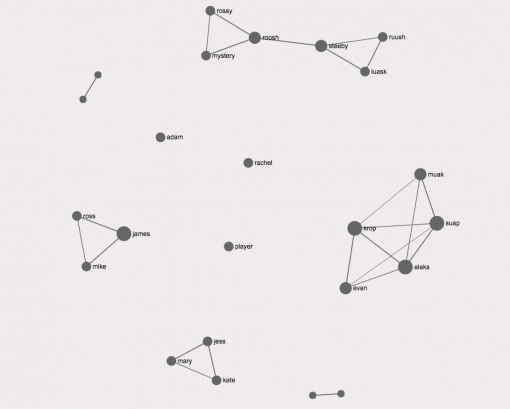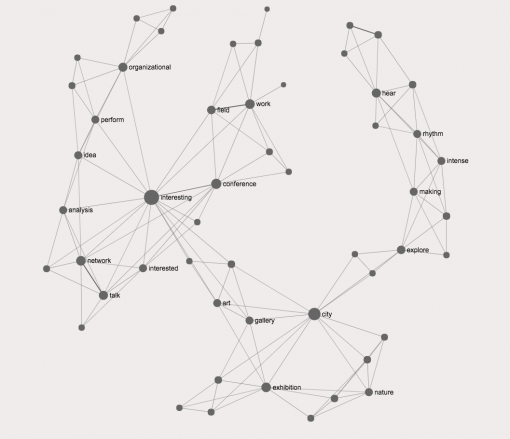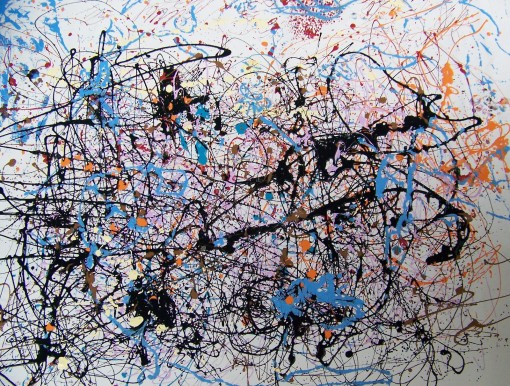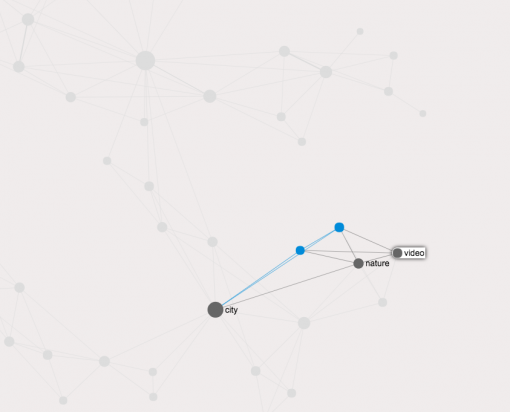Posted by Nodus Labs | August 23, 2016
“The Game” and Social Dynamics of Pick-Up Artists
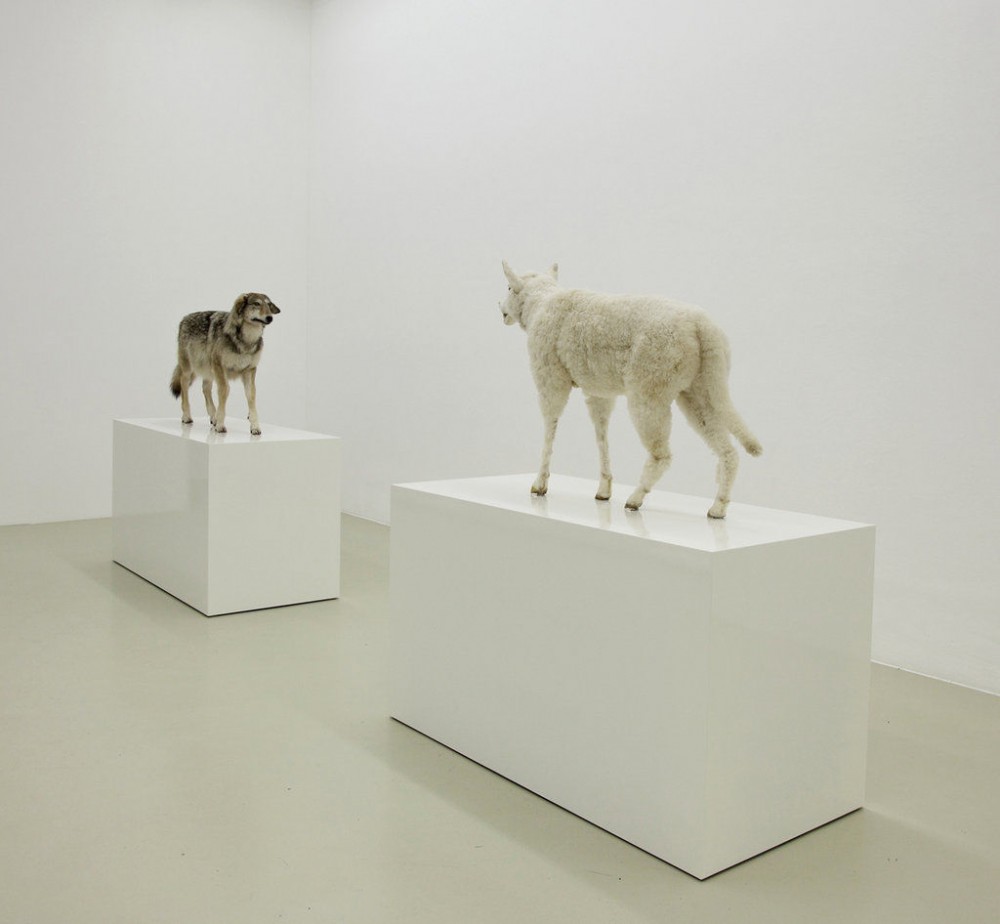
Basic principles of network operation can be successfully used for establishing a new kind of ethics for social encounters. Normally people approach each other with a fixed set of expectations, codes and rules of interaction. This multidimensional grid of values and beliefs is functional to the extent that it works, however, every social situation can be enhanced when new behaviors are introduced to activate new agents within the network, stimulate exchange, and introduce novel ways of connecting to one another.
Some readers may be familiar with the method called “The Game”, which is utilized by so-called “pick-up artists” to meet women and build attraction. It was popularized by the best-selling book “The Game” written by a New York Times reporter Neil Strauss who initially wanted to infiltrate the “pick-up artist” society in order to expose its inner workings, but ended up becoming a part of the movement (his nickname is now “Style”), contributing to its popularity.
While the original purpose of “The Game” may be not as interesting for some researchers, there are many reports indicating that this method is successful in what it does: that is, meeting random strangers, building rapport, and creating attraction. In fact, Neil Strauss himself is the best example that this method works: a sceptic turned into convert himself.
So on a more abstract level, “The Game” can be seen as an effective mechanism of initiating contact and building rapport and attraction in unfamiliar social environments. We decided to study the methodology utilized in “The Game” from the network science perspective, further expanding our research on polysingularity of social dynamics, embodying social networks workshop, and social influence dynamics.
Some of the main players in the field include “Mystery”, Ross Jeffries (also an NLP trainer) and Roosh V. While they all have a different style, their techniques have a lot in common. The basic strategy utilized can be separated into three parts:
1) Initial Approach
2) Establishing Rapport
3) Building Attraction
We will analyze each of those steps in detail from the network perspective below.
1. Initial Approach
We represent the initial situation as a network, N, which is a representation of the current social situation.
In a standard social situation the network will usually (at least, initially) consist of the groups of 2-3-4 people who know each other. Those groups don’t have any contact except for some of them with mutual acquaintances. We visualize this network below using InfraNodus software. The people are the nodes and their connections are interactions between them.
When the node P (player) enters into the field, they are faced with disjointed clusters and groups. If the initial intention is to approach some of those groups, the task can be seen as establishing links with those different groups in order to build rapport with each of them.
In a standard social situation this initial approach is made more difficult by various learned behaviors (shyness, laziness, fear etc.) However, if the situation is seen from a more abstracted network perspective, a different set of behaviors becomes readily available.
The basic action that transforms network connectivity is to establish or break a connection. When a new agent is introduced into a social network they can start building connections with already existing agents and subgroups.
There may be two different approaches here.
One is to make brief encounters with each group and become a central node in the network that connects all of those groups together. The advantage will be experienced by the whole network, because as soon as all the disjointed clusters are interconnected, it becomes much easier for them to act collectively and synchronize. This, in turn, may lead to interesting collaborations or at least a good party (see more details in our talk on social dynamics at re:publica and in our research on viral social contagion and exclusive inclusivity).
Such behavior also increases betweenness centrality of the node performing this sort of behavior, making them a potential connector hub between those different communities and increasing their influence in the network.
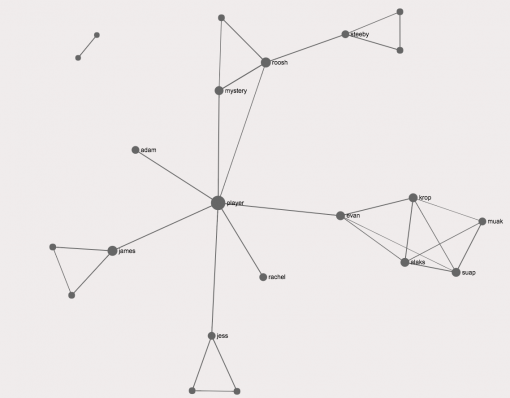
Another approach would be to focus on building rapport with only one group or individual if the further task is to generate attraction within that particular cluster and not in the whole network at large.
A good strategy is combination of those two approaches above. First the protagonist establishes high betweenness centrality for itself (often increasing their social value in the network this way) and then focuses on one group in particular. The mindset that emerges as a result of this “connectivist” approach is to simply establish new links in a network without any particular outcome at first. This makes it easy to approach individuals and groups as the value of each individual social interaction at this point is not high, it’s more about the network in general. The more links are created, the better.
On a more practical level, the initial rapport is built is through so-called “social hooks” or “openers”.
These can range from a simple “Hi” to a more elaborated “environmental opener”, which takes into account the current environment or uses a prop to start up a conversation (“you look like you’re having a lot of fun here” or “is this the last iphone model you have?”). Another way to start are so-called “opinion polls” where a stranger’s opinion is asked on a specific subject. In any scenario the intention is to establish the first contact that goes beyond a simple binary yes or no question and flows into a conversation (so that a deeper .
What seems to be important in all the instances above to “The Game” methodology is to establish the dynamics of approach and withdrawal early on. This is because the intention is not only to build temporary links, but to create attraction (step 3). And unless it happens from the first sight, such dynamics can be established through push and pull behavior. A practical implementation of this is to introduce false time constraints (“I can only join for a minute”) or acting as if one is going to leave. Some other techniques use so-called “negs” – criticisms framed as compliments, which reject first in order to attract after.
All these behaviors may be considered manipulative, but they are simply derived from basic cultural and psychological traits most people share. So while they attract a lot of criticisms it’s also important to consider the reasons why they actually might work (if they did not, they would be considered stupid, which is an interesting realm outside of the scope of this study). This would allow to direct the criticism not towards the symptoms but to the actual roots of the problem (the need to be appreciated, desire for social acceptance, the inner workings of desire, etc.)
Another concern with those behaviors might belong to the ethical realm. Many find it difficult to approach strangers. However, it all depends on the motivation and the point of view (especially how one sees themselves in the social situation). The representation above, where the person who makes the approach is a node and the rest is a network, is abstract enough to exclude any social difficulties that may arise. The general rule is to not give too much importance to the existing links themselves before they are established. Those links represent the existing context and what is being done instead is the introduction of the new context. So the basis for connectivity will change, therefore the current links are not relevant. Some techniques even recommend to start from the worst scenario (imagining the whole network turning against the protagonist) – which helps temporarily remove the existing links in the network making it easier to begin building the new ones. In this case, there’s a situation of nothing to lose and thus it’s easier to transcend one’s own moral and ethical limitations and to instead pursue this social experiment to its fullest extent.
2. Establishing Rapport
The next stage is to start building rapport. This is done through conversational threads – introducing short topics that are as much varied as possible and utilize everything from the immediate environment and available props to the personal life, beliefs, and aspirations.
As we are now focusing on a one-on-one interaction (a pair or a person from another group), we can zoom into that link and represent the actual exchange of ideas and concepts that happens as a network as well. Using text network analysis we can show conversational threads as a graph where words (and ideas) are the nodes and their co-occurrences are the connections between them (visualized with InfraNodus below) . What happens at this initial stage of building rapport is a quick reiteration of as many different possible distinct clusters as possible. So the conversation will look dispersed from the outside but in fact it’s just working on covering as large territory as possible to learn about possible threads that may be interesting to both parties to pursue further.
A typical conversation would look something like this: there are a few keywords and several different topical clusters or threads are covered initially in a superficial way to learn about each other’s preferences and interests.
The approach can be exemplified with making short strokes on a canvas without going deep into any of them. It establishes the light, unobtrusive and smooth dynamics, which is conducive for building rapport. It is based on a series of approaches and withdrawals, as well as pacing and leading to build a comfort zone within the short span of the conversation. Some practitioners call it “rambling” an “elderly chat” referring to the way old people like to chat everyone up just for the sake of keeping a conversation and entertaining themselves.
However, at some point, it needs to change into a more in-depth conversation in order to shift from building rapport to creating attraction.
3. Building Attraction
The last stage of the process is to start building attraction. For the proponents of the game this means going into a deeper conversation, establishing a more intimate space. It is in this stage that the push / pull game intensifies also and various manipulative techniques such as punishment / reward come into play.
By now some basic topics have been covered, the rapport has been built, so it is time to zoom into a topic (or – even better – introduce a new one that would unify all of the disjointed topics of an earlier conversation). In terms of graph representation that means zooming into one of the clusters and expanding it further or introducing a few new concepts that unify all the territory covered before. Some Game practitioners call it “conversational routines“, which are established to shift from comfort to intimacy.
Intimacy has to do with friendship, the same is true for the conversational routines. They attempt to shift interaction towards the realm of attraction. The kind of conversational routines that work in this way, according to the many “Game” practitioners are the ones based on differences. A topic is brought up and opinions are expressed. The conversational routine will be much more successful if those opinions are different, so there is a certain tension that will be resolved through the conversation that ensues (in that way those conversational routines act as metaphors for the functioning of desire).
Mindstate
Every “game” of experimenting in the field of social interaction comes with a set of values that seem to be consistent among all the different approaches. Their importance seems to stem from the need order to counter the standard norms of behavior, morals and ethics that often obstruct interactional flows.
1) High Value
The protagonist needs to establish a high social value. Evaluating, not being evaluated. Not caring so much about the opinion of the others. Otherwise one may start having feelings of not being “worthy”, “shy”, etc.
2) Model of Abundance
The model of abundance implies that there is no more importance give to a particular interaction than others. This way many of them may occur and there’s not a particularly strong attachment to their outcome. Otherwise there is too much focus on the specific interaction instead of the procedure in general.
3) Strong Intention
The intention seems to be an important aspect of interaction. Whether it is to get a business contact or to build intimate attraction, it is important to keep it “strong in the mind, assertive through actions, and vague in words” quoting Roosh V, one of the “Game” practitioners.
4) Private Ethics
A temporary suspense on the rules of the context or ethical norms on the public behavior seem to be necessary in order to be able to experiment freely. Otherwise, the experiment will be biased and some actions will be impossible to perform. Every social experimentator seems to have their own idea of what “proper” behavior really mean. It is a more honest approach to the actual etymology of this word, which means something that belongs to the individual, rather than the society. So the notion of “proper” behavior is the one that relates to the individual first and to the society after.
5) Impulsivity
Impulsivity is an important aspect of social experiment. The ability to follow the waves and impulses and not think twice before doing something. Making mistakes, failing, succeeding, and moving on.
6) Non-Attachment
A truly buddhist approach: everything is changing, there is no need to get stuck on one particular person / interaction / event / success / failure. It is important to move on for the sake of experiment itself.
7) Indirectness
The movement is never direct but, rather, oblique. The approach always happens from sideways and the final outcome is not clear from the very beginning.
8) Oscillation
Oscillatory dynamics establishes the basis for desire and attraction to build up. Push / pull, reward / punish, dominance / submission (and exchanging roles in order to keep the dynamics stable). See more on the dynamics of conflict.

